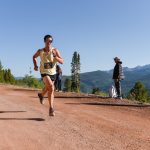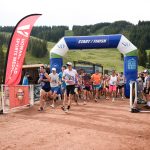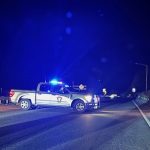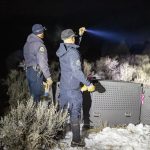A daring and dangerous mission
cschnell@vaildaily.com

If you go ...
What: Kevin Fedarko, author of “The Emerald Mile.”
Where: Bookworm of Edwards.
When: 6 p.m. today.
Cost: $10, includes appetizers. Cash bar available.
More information: Call 970-926-READ.
Author Kevin Fedarko was camped at Stone Creek, one of the deepest points in the Grand Canyon, when he first heard the story of the boat named the Emerald Mile, and the three brave-but-undoubtably-crazy river guides who launched the small wooden dory into the Colorado River, just below the Glen Canyon Dam’s base, during the legendary flood in 1983. Their goal was to be the fastest boat ever propelled through the heart of the Grand Canyon. Riverguide Martin Litton, the man who was responsible for originally bringing the dory boats of Oregon and New England into the Grand Canyon, relayed the tale to Fedarko.
“The story of the Emerald Mile’s speed run is part of the fabric of the oral history of the Grand Canyon — the loosely knit collection of yarns, anecdotes, and river stories that the guides of the canyon share with their passengers at night around the campfire,” Fedarko said. “This particular story is also included in little anthology of Grand Canyon boatmen’s stories entitled ‘There’s This River,’ which most guides carry on board their boats and from which many of them read to their passengers at night.”
If you’re ever lucky enough to take a river trip through the Grand Canyon, it’s quite likely that you’ll hear the story of the Emerald Mile, and the three men — the boat’s captain Kenton Grua, Rudi Petschek and Steve “Wren” Reynolds — at some point on your journey, Fedarko said. And if you’re not that lucky, you can read about the epic adventure in Fedarko’s book, “The Emerald Mile,” which was released May 7. Fedarko visits The Bookworm of Edwards this evening for an author event. He’ll do a reading from the book, answer questions and sign copies of the book. We caught up with Fedarko, a former senior editor for Outside magazine and a part-time river guide, earlier this week.
Vail Daily: What made you want to tell this story?

Support Local Journalism
Kevin Fedarko: Three reasons. First, it seemed like a terribly exciting adventure story — one of the few such stories inside the Grand Canyon that, at least in my view, rivals that of the greatest river story of all: John Wesley Powell’s pioneering river trip through the canyon in the summer of 1869. Second, in the course of working inside the canyon as a boatmen, I became obsessed with dories: their beauty, their grace, and the extraordinary feats they are able to achieve inside the canyon’s ferocious hydraulics when the right set of hands is at their oars. Third, and perhaps most importantly: it seemed to me that the story of the Emerald Mile was, in the end, more than simply a turbo-charged tale of a speed run. In addition to being that, it somehow seemed to encapsulate the larger story of the canyon itself: its discovery and its exploration, as well as the complicated and fascinating narrative of the Glen Canyon Dam. All of those elements came together — quite violently, as it turned out — during the spring and summer of 1983, when the runoff of the Colorado River achieved a size and speed that had not been witnessed in generations. And the speed run braids those elements together in a manner that is, at least in my view, irresistibly compelling. I don’t know of another Grand Canyon River story that encapsulates everything about that unique and special place as succinctly and powerfully as that of the speed run.
VD: Do you know the three men?
KF: Unfortunately, Kenton Grua had passed away by the time I came to the river and decided to embark upon this project. (He died in the fall of 2002 as a result of an aortic dissection while riding his mountain bike outside of Flagstaff.) I was, however, able to interview Steve “Wren” Reynolds extensively in the summer of 2011 about six weeks before he passed away from liver cancer. As for Rudi Petschek, he and I came to know one another quite well during the course of putting this book together. I spoke with him at length in a series of long interviews at his home in Nevada City, Calif., during the summer of 2010, and then we continued our dialogue over the course of the next three years through countless e-mails and phone calls. Without his assistance, the book never would have been possible.
VD: Do you consider the men’s decision to raft the river during that time heroic or irresponsible?
KF: Both. And that’s part of what makes the story so fascinating to me (and also, I hope, to readers). What they did was dangerous, illegal, wrong-headed, and highly irresponsible — a breach of the rules, both written and unwritten, that govern conduct at the bottom of the canyon, and adherence to which is perhaps the principle reason why the bottom of the Grand Canyon doesn’t look like the parking lots at Yosemite, the geysers at Yellowstone, or so many other prominent features in our National Park System that have been overdeveloped and, as result, robbed of much of their original magic. But at the same time, the adventure upon which they embarked was also glorious. Many old rivermen with whom I spoke and who roundly condemned Grua and his team for what they did also admitted, under their breath, that in their darkest moments, they wish they had been given a chance to participate in the speed run. There has never been anything like it — and probably never will be again. And on a symbolic level, it enabled three rather deranged, but also herioc, oarsmen to participate, in the most direct and visceral way one could imagine, in the ancestral fury of what was once the wildest free-flowing river in the American West, and which now bears a closer resemblance to a municipal plumbing system. There’s hardly a person out there who doesn’t know and love the canyon and the river that runs through it that doesn’t find the speed run both ludicrously bone-headed… and a subject of bottomless envy.
VD: How did the men name their boat the Emerald Mile?
KF: It was Martin Litton, the man who was responsible for originally bringing the dory boats of Oregon and New England into the Grand Canyon, who developed the tradition of adorning each of his dories with the name of a natural wonder that had been destroyed — unnecessarily and unforgivably, in Litton’s eyes — by the hand of man. “To serve as a reminder of what we did to those places,” he would declare, “so that maybe we’ll think twice before doing it again.” For the boat that is at the center of this book, Litton selected the name of a towering stand of old-growth redwood trees in northern California, a portion of which was clear-cut during the 1960s by a logging company in the hopes of rendering the grove unsuitable for inclusion in a national park. “Truly something to cry about,” Litton railed at the time. And so she became the “Emerald Mile.”
VD: Do you still work as a part-time river guide? How does that part of your life inform your writing and help you specifically with this book?
KF: I completed 14 trips through the Grand Canyon as an apprentice river guide before the demands of finishing this book confined me to my desk. It’s been three years since my last trip through the canyon. One of the things I most look forward to, when the publicity and book-touring is finally complete, is once again getting behind the oars of my toilet boat, which is called the Jackass. As for the second part of the question — how did that part of my life inform my writing? — the answer is, simply: in every way one could possibly imagine. The descriptions of the canyon — the rock, the light, the colors, the weather, the birds and animals, the feel of the place, and above all and always, the magic and the brutality of the whitewater — all of that writing arose directly from my experiences as a boatman.
VD: Tell me about some of the research you did for this book?
KF: The research was rather complicated and time-consuming. For the speed-run narrative, most of the work involved tracking down old dorymen and retired river guides and park rangers and passengers — anyone who knew the members of the speed-run crew or who were present in the canyon during the massive flood that unfolded in June of 1983 — and piecing together their impressions and memories. I also was able to unearth a series of extremely detailed “Case Incident Reports” filed by NPS rangers that chronicled a number of horrific accidents that took place on the river as the speed run was taking place, and which were crucial in enabling me to piece together the “river chronicle.”
As for the events that took place up at the Glen Canyon Dam — the “spillway crisis” narrative that is braided into the story of the speed run — much of that research would be familiar to a professional historican: rifling through cardboard boxes at the Bureau of Reclamation’s archives in Denver, combing through a wealth of primary materials — memos, faxograms, telephone logs, diary entries, handwritten notes, etc. — and slowly piecing together a chronicle of exactly what took place at the dam, and how the team of engineers and managers who were responsible for confronting the spillway crisis ultimately solved that challenge. Those documents also yielded names of BuRec employees, all of whom are now retired, thus enabling me to track them down and interview many of them in order to mine their memories.
VD: How long did it take you to put together? And what was the hardest part for you?
KF: The whole process took five years. The hardest part was assembling the treasure-trove of information into a coherent narrative, and deciding what to leave out.
In the end, building a story is sort of like running a Class V rapid. It’s intensely confusing and chaotic — there are rocks and standing waves and spray flying in every direction. More than anything else, threading one’s way through the mess hinges on finding a clear line that will enable you to cut through the madness and arrive at the bottom without flipping upsided-down or seeing your boat smashed to pieces. One big difference, however, is that while whitewater is exhilarating and fun, writing is pure donkey work.
High Life Editor Caramie Schnell can be reached at cschnell@vaildaily.com or 970-748-2984.










